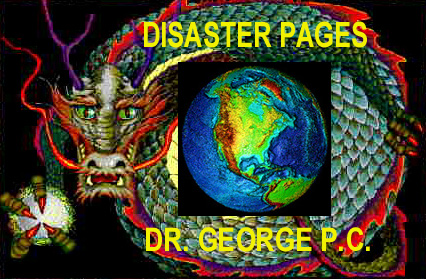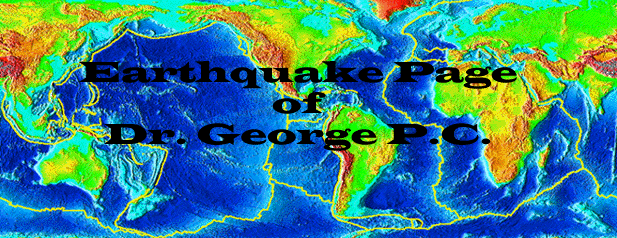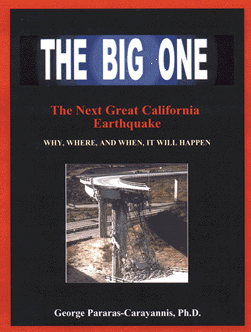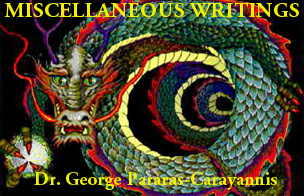|
THE EARTHQUAKE
AND TSUNAMI OF 12 DECEMBER 1979 IN COLOMBIA
George Pararas-Carayannis
(Excerpts
from a survey undertaken from December 20, 1979 to January 5,
1980, in Colombia and Ecuador and from Report submitted to the
Intergovernmental Oceanographic Commission and to the International
Coordination Group for the Tsunami Warning System in the Pacific(ICG/ITSU).
 ( (
INTRODUCTION
A major earthquake
measuring 7.9 on the Richter scale occurred at 07:59:4.3 (UT)
on 12 December 1979 along the Pacific Coast  of
Colombia. The 12 December 1979 earthquake and tsunami associated
with it, were responsible for the destruction of at least six
fishing villages and the death of hundreds of people in the State
of Narino in Colombia. The earthquake was felt in Bogota, Cali,
Popayan, Buenaventura and other major cities and villages in
Colombia, and in Guayaquil, Esmeraldas, Quito and other parts
of Ecuador. of
Colombia. The 12 December 1979 earthquake and tsunami associated
with it, were responsible for the destruction of at least six
fishing villages and the death of hundreds of people in the State
of Narino in Colombia. The earthquake was felt in Bogota, Cali,
Popayan, Buenaventura and other major cities and villages in
Colombia, and in Guayaquil, Esmeraldas, Quito and other parts
of Ecuador.
An investigation of
the effects of the earthquake and tsunami was undertaken by ITIC.
Tumaco and San Juan Island -- two of the areas that were most
affected by the earthquake and tsunami were visited and surveyed.
Because of the inaccessibility of the area destroyed by the earthquake
and tsunami, all of the coastal villages were not visited. However,
reports of earthquake and tsunami effects, as well as casualty
and damage figures, were compiled from Civil Defense records
and eyewitness accounts. The following is an account of the ITIC
investigation.

THE EARTHQUAKE
 The
earthquake measured 7.9 on the Richter scale (MS) and occurred
at 07:59:4.3 (UT) on 12 December 1979. The epicenter of the earthquake
was in the ocean at 1.584° North Latitude and 79.386°
West Longitude. The origin time, magnitude and epicenter location
have been reported by the U.S. National Earthquake Service (NEIS)
in the preliminary report (PDE #50-79, 9 Jan 1980) and are based
on the averages reported from 171 seismic stations around the
world. The standard deviation in epicenter determination of the
12 December event given by NEIS is 1.1 seconds which translated
into distance it means that the epicenter could be within a circle
of approximately 8 nautical miles, as given in Figure 1. This
epicenter is a refinement of the preliminary epicenter which
had been given as 2.4 North and 79.0 West, immediately following
the event. The refined epicenter is considerably further to the
south and to the west than that given earlier and it is nearer
the Colombian-Ecuadorian border. The
earthquake measured 7.9 on the Richter scale (MS) and occurred
at 07:59:4.3 (UT) on 12 December 1979. The epicenter of the earthquake
was in the ocean at 1.584° North Latitude and 79.386°
West Longitude. The origin time, magnitude and epicenter location
have been reported by the U.S. National Earthquake Service (NEIS)
in the preliminary report (PDE #50-79, 9 Jan 1980) and are based
on the averages reported from 171 seismic stations around the
world. The standard deviation in epicenter determination of the
12 December event given by NEIS is 1.1 seconds which translated
into distance it means that the epicenter could be within a circle
of approximately 8 nautical miles, as given in Figure 1. This
epicenter is a refinement of the preliminary epicenter which
had been given as 2.4 North and 79.0 West, immediately following
the event. The refined epicenter is considerably further to the
south and to the west than that given earlier and it is nearer
the Colombian-Ecuadorian border.
It is a little difficult
to explain the earthquake effects in the State of Narino, Colombia
and the absence of considerable damage in Esmeraldas, and other
cities and villages of Ecuador which were fairly close to the
revised epicenter. One would have to examine carefully the structural
geology of the area to determine why the earthquake had far more
severe effects in Colombia than it had in Ecuador. For example,
the presence of an offshore ridge was determined by the preliminary
examination of a small scale bathymetric chart of the area. This
ridge is in the vicinity of the epicenter has an orientation
in a northwest southeast direction. The ridge may be in fact
part of an extensive fault line along which many historical earthquakes
may have occurred.
Other underwater ridges
exist offshore from Tumaco, indicating a complex system of geological
structures in the area. In the absence of comprehensive geological
information for the area it is not possible to speculate on the
source mechanism of the earthquake at this time. However, an
attempt is made to partly explain the characteristics of the
tsunami generating area on the basis of scant field evidence
and observations made during the ITIC survey.

EARTHQUAKE EFFECTS
The earthquake of
12 December 1979 centered in the State of Narino in the southwest
corner of Colombia, bordered to the south by Ecuador and to the
west by the Pacific Ocean. The shock was felt over a wide area
ranging from Bogota to the north to Quito and Guayaquil to the
South. The quake had three major shock waves which according
to reports lasted from 2:59 AM until 3:04 AM, local time (0759
to 0804 UT).
This `was the strongest
earthquake in that part of Colombia since 19 January 1958 when
an event of 7.8 in magnitude occurred. It was the second large
earthquake to occur in Colombia within a month. An earthquake
of magnitude 6.7 on the Richter scale occurred further north
of the State of Narino in Colombia on 23 November 1979, killing
44 persons, injuring hundreds and causing extensive damage.
According to the Geophysical
Institute of Javeriana University, there were at least 10 major
aftershocks lasting for several days following the major event
of 12 December. The violent quake left numerous dead and injured
and destroyed thousands of buildings principally in the State
of Narino, Colombia. In Bogota and other major cities in Colombia,
tall buildings swayed, but damage was not significant. The shock
was felt throughout Ecuador and caused some damage in villages
and towns near the Colombian border, but no casualties were reported
from that country.
The State of Narino
is one of the least developed areas of Colombia, and there is
lack of roads and runways making it one of the most inaccessible
areas of the country. Most of the inhabitants live in villages
and towns on the coast or near waterways, as the area is mostly
jungle. Preliminary reports estimated the number of persons killed
in the hundreds with up to 2,000 people missing. The area was
declared a disaster area, and Army, Navy, and Civil Defense officials
began rescue and supply operations quickly after the disaster
struck. Electrical power and telephone lines were knocked out
in several areas of the State of Narino, but were quickly restored
a few days later. At the time of the ITIC survey in the last
week of December 1979, there was still lack of potable water
in the area.
Hardest hit by the
earthquake and the tsunami was Charco, a Colombian fishing village
of 4,000 persons -- about 300 kilometers north of the Ecuadorian
border, where 100% of all the houses were either seriously damaged
or totally destroyed. Most of the houses at Charco were built
on stilts over a lake. It is not known at this time whether the
houses were destroyed by the earthquake or by wave action. Numerous
deaths and injuries were reported from this area. Most of the
victims were women and children. Hundreds of people at Charco
had to sleep on the ground following the disaster, and had to
go without food and drinking water for several days. The landing
strip at Charco was inundated, becoming unusable for relief operations.
Most of the supplies had to be flown to the airport in Guapi,
about 30 kilometers from Charco.
The second populated
area that was hardest hit by the earthquake was the seaport of
Tumaco, only about 80 kilometers from the earthquake epicenter.
At least 40 persons were killed and 750 injured by the earthquake,
which destroyed approximately 10% of the houses and other buildings
in the town of 80,000. Included in the buildings that were destroyed
was the four-story Las Americas Hotel.
Tumaco is built on
an island made up of alluvial deposits of Rio Mira and Rio Caunapi.
In fact the whole area appears to have formed from deltaic deposits.
Evidence of liquefaction was evident in many areas of the city
of Tumaco where structures failed and it was particularly evident
along sections of the waterfront. Evidence of subsidence was
found on either side of the bridge connecting the island where
Tumaco is situated to the island where the airport is located.
It appeared that the island dropped by as much as 60 centimeters.
Evidence of subsidence of about 60 centimeters also was reported
from the island of Rompido, offshore from Tumaco, and a good
portion of that island was under water. Subsidence of approximately
50 centimeters was reported from Cascaja1 Island. Other fishing
villages in the State of Narino that were destroyed were Curval,
Timiti, San Juan, Mulatos and Iscuande. Most of the damage and
deaths in these villages, however, were the result of the tsunami.
Earthquake
Damage at Tumaco, State of Narino, on Colombia's Pacific side
(Photos by G. Pararas-Carayannis)


 
TSUNAMI EFFECTS
 The 12 December 1979 earthquake
resulted in a tsunami that practically wiped out six of the coastal
fishing villages along Colombia's southwest Pacific coast and
left hundreds of persons dead or missing. At least 15 other coastal
towns in the area were rocked by the earthquake and were damaged
by the waves. Waves measuring anywhere from 2-5 meters destroyed
many of these coastal villages. People along the coast, who survived
the earthquake by running outside their homes were carried away
a few minutes later by the large tsunami waves generated by the
earthquake. Six fishing boats, one with 40 men aboard, were lost.
A pier on the prison island of Gorgona was destroyed, however,
no injuries from either the earthquake or the tsunami were reported
from there. Most of the houses at Charco, a village of 4,000,
which were built on stilts over a lake were knocked into the
water. Waves sent the Iscuande River out of its banks along the
Pacific coast. The wall of water reportedly in the village of
Iscuande caused extensive damages. At least one person was reported
dead from that area. The 12 December 1979 earthquake
resulted in a tsunami that practically wiped out six of the coastal
fishing villages along Colombia's southwest Pacific coast and
left hundreds of persons dead or missing. At least 15 other coastal
towns in the area were rocked by the earthquake and were damaged
by the waves. Waves measuring anywhere from 2-5 meters destroyed
many of these coastal villages. People along the coast, who survived
the earthquake by running outside their homes were carried away
a few minutes later by the large tsunami waves generated by the
earthquake. Six fishing boats, one with 40 men aboard, were lost.
A pier on the prison island of Gorgona was destroyed, however,
no injuries from either the earthquake or the tsunami were reported
from there. Most of the houses at Charco, a village of 4,000,
which were built on stilts over a lake were knocked into the
water. Waves sent the Iscuande River out of its banks along the
Pacific coast. The wall of water reportedly in the village of
Iscuande caused extensive damages. At least one person was reported
dead from that area.
Hardest hit of all
the coastal villages was the fishing village of San Juan, where
the waves completely overran the island destroying just about
everything in their path. Numerous deaths were reported from
San Juan which was totally devastated and is in the process of
being relocated further inland at the present time. According
to eyewitness reports, 3 to 4 waves were observed, the first
wave arriving approximately 10 minutes after the main earthquake.
The water recessed first to about 3 meters below the level of
the sea. The first wave arrived minutes later. The third wave
was the largest, and at San Juan Island it was approximately
5 meters above the level of the tide, which fortunately, was
at its lowest at that time.
The maximum difference
between low and high tide in the region for that time of the
year was approximately 1.3 meters, thus, the maximum wave could
have been that much more, if it had arrived at high tide, and
numerous more deaths could have resulted. Considering that the
mean elevation of the coastal islands is approximately 2 - 2
1/2 meters above high tide, it would mean that maximum waves
would have completely overrun all of the coastal islands in the
area. Approximately 30-35 kilometers of the coast were hardest
hit by the tsunami, while the length of the area hardest hit
by the earthquake was approximately 225 kilometers in length,
from Guapi to Tumaco.
Table 1 was compiled
from Civil Defense records, and gives casualties and damages
from the combined effects of the earthquake and tsunami. These
government figures in actuality are underestimates. The earthquake
and tsunami may have resulted in numerous more deaths than those
given in the official estimates, since the census figures for
the area are at least ten years old, and since final tabulation
had not been made at the time of the ITIC survey. It is estimated
also that the majority of casualties (at least 807) were the
result of the tsunami rather than of the earthquake. Because
of the inaccuracy of the census figures, it may be difficult,
even in the future, to determine the number of people that lost
their lives. It is also difficult to separate the deaths caused
by the earthquake from those that were caused by the tsunami.
An ITIC estimate based on informal reports is that 500-600 people
may have been killed by the combined effects of the earthquake
and tsunami with about 4,000 people injured. Homes of at least
10,000 persons were destroyed. Final and more accurate estimates
will be provided at a later time.
Tsunami Damage
at Tumaco, State of Narino, on Colombia's Pacific side (Photos
by G. Pararas-Carayannis)
 

Table 1. Preliminary
Casualties and Damage Estimates of Combined Effects of Earthquake
and Tsunami of 12 December 1979
Municipality (Dead
Hurt Missing Houses Destroyed)* As of 27 December 1979, compiled
by local Civil Defense Authorities. Suspected to be considerab;y
higher
Tumaco: 38 dead , 400 hurt, 7 missing,
1,280 houses destroyed
El Charco: 43 dead 300 hurt 50 missing,
All houses destroyed
San Juan : 161 dead. 70 hurt 38 missing,
All houses destroyed
Mosquera : 4
Majagul: 12 dead, 28 hurt, 20% of all
houses destroyed
Salahonda: 1 death
TOTAL: 259 dead, 798 hurt, 95 missing

The Tsunami of 12 December
1979 earthquake as recorded in Esmeraldas, Ecuador.
 This tsunami record was obtained
from the port of Esmeraldas in Ecuador, approximately 95 nautical
miles to the south of the epicenter. It is confirmed from this
record that the tsunami occurred at the lowest possible tide,
that the first wave activity was a recession followed by approximately
3 to 4 waves. No tsunami damage occurred in Tumaco (Colombia)
or Esmeraldas (Ecuador), but had the wave occurred at high tide,
it is believed that flooding and considerable tsunami damage
would have occurred at these two cities. For example, if the
wave had occurred at high tide, its elevation would have been
1-3 meters higher than the 1 meter wave observed in Tumaco, and
could have resulted in extensive tsunami damage of that city. This tsunami record was obtained
from the port of Esmeraldas in Ecuador, approximately 95 nautical
miles to the south of the epicenter. It is confirmed from this
record that the tsunami occurred at the lowest possible tide,
that the first wave activity was a recession followed by approximately
3 to 4 waves. No tsunami damage occurred in Tumaco (Colombia)
or Esmeraldas (Ecuador), but had the wave occurred at high tide,
it is believed that flooding and considerable tsunami damage
would have occurred at these two cities. For example, if the
wave had occurred at high tide, its elevation would have been
1-3 meters higher than the 1 meter wave observed in Tumaco, and
could have resulted in extensive tsunami damage of that city.

TSUNAMI GENERATING AREA
 Preliminary assessment of the
tsunami generating area indicates that the orientation of the
generating area was an ellipse with the major axis being in a
northern direction (Figure 1). However, this is preliminary and
will be refined when more mareographic data is collected. Preliminary assessment of the
tsunami generating area indicates that the orientation of the
generating area was an ellipse with the major axis being in a
northern direction (Figure 1). However, this is preliminary and
will be refined when more mareographic data is collected.
Epicenter of
Earthquake and Preliminary Tsunami Generating Area (Modified
later with a more North-South orientation)
Because of the orientation
of the generating area, it appears that coastal areas to the
south and to the north of the generating area were not affected
greatly by the tsunami. Minimum tsunami energy was propagated
to the north or to the south of the generating area explaining,
for example, why Tumaco experienced relatively small tsunami
waves although so close to the generating area. At San Juan Island,
where maximum waves were observed, the direction of approach
of the waves was from the southwest, rather than from the west.
The direction of wave
approach was obtained by observing fallen palm trees, detritus
material wrapped around objects and the way buildings had moved
or structurally failed. When he mareographic records from Buenaventura
and Tumaco become available, it will be easier to reconstruct
the generating area of the tsunami. Based on the record obtained
from Esmeraldas, it appears that the travel time to that tide
station was only 5-6 minutes after the quake.
Refraction Diagram
and Travel Time Chart of the 12 December 1979 Tsunami Across
the Pacific Ocean

The tsunami generated
in Colombia was also observed in many places of the Pacific including
the Hawaiian Islands. It took a little over 12 hours to reach
Hawaii. At Hilo and at Kahului, maximum wave observed (trough
to crest) was approximately 40 centimeters. At Nawiliwili the
wave was only 10 cm. At Johnston Island the wave was only 8 cm.
A deep water gauge off the coast near Tokyo, Japan did not record
any wave activity. Figure 3 is a computer-generated tsunami refraction
diagram and travel time chart for the 12 December 1979 tsunami
across the Pacific Ocean (Steve Poole, Personal Communication).
REFERENCES
Pararas-Carayannis,
George, Survey of
the Earthquake and Tsunami of December 12, 1979, in Colombia. Intern. Tsunami Information
Center Report, Abstracted article in Tsunami Newsletter, Vol.
XIII, No. 1, January, 1980.
Pararas-Carayannis,
George. International
Tsunami Information Center - A Progress Report For 1979-1980. VII Session of the International
Coordination Group for the Tsunami Warning System in the Pacific,
Vina del Mar, Chile, March 3-7, 1980
 Return to
Return to

  Links to other
Pages
Links to other
Pages

 Now available
from Amazon, Barnes and Noble and other major bookstores. A signed
by the author copy can be also ordered by contacting directly
by email Aston
Forbes Press.
Now available
from Amazon, Barnes and Noble and other major bookstores. A signed
by the author copy can be also ordered by contacting directly
by email Aston
Forbes Press.
 Other
Miscellaneous Non-technical Writings
Other
Miscellaneous Non-technical Writings
 (©) Copyright
1963-2007 George Pararas-Carayannis / all rights reserved / Information
on this site is for viewing and personal information only - protected
by copyright. Any unauthorized use or reproduction of material
from this site without written permission is prohibited.
(©) Copyright
1963-2007 George Pararas-Carayannis / all rights reserved / Information
on this site is for viewing and personal information only - protected
by copyright. Any unauthorized use or reproduction of material
from this site without written permission is prohibited.
|